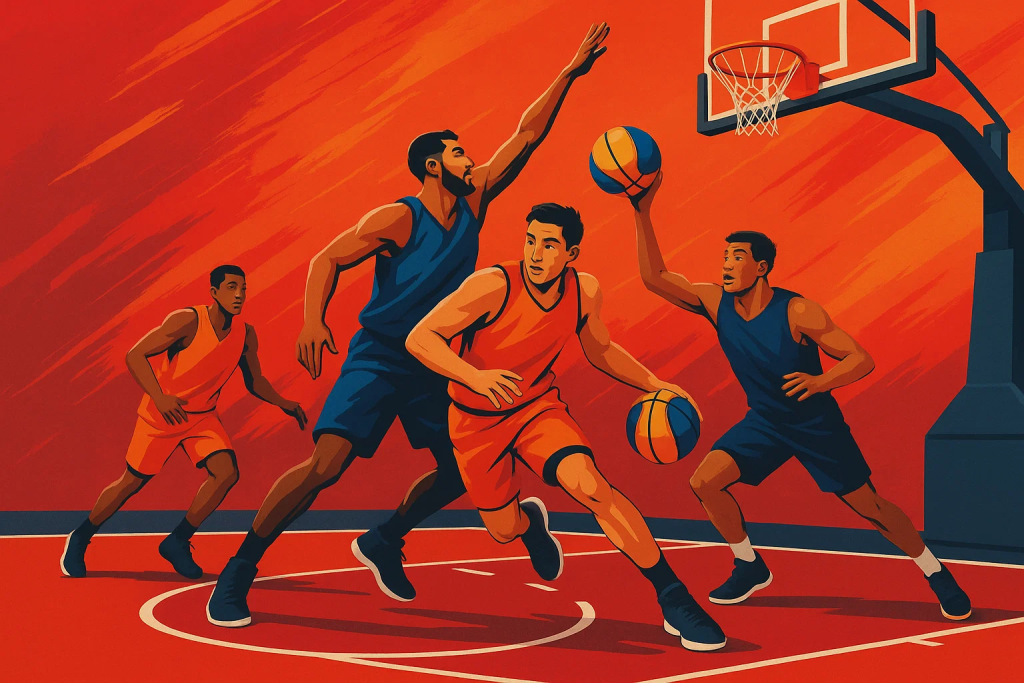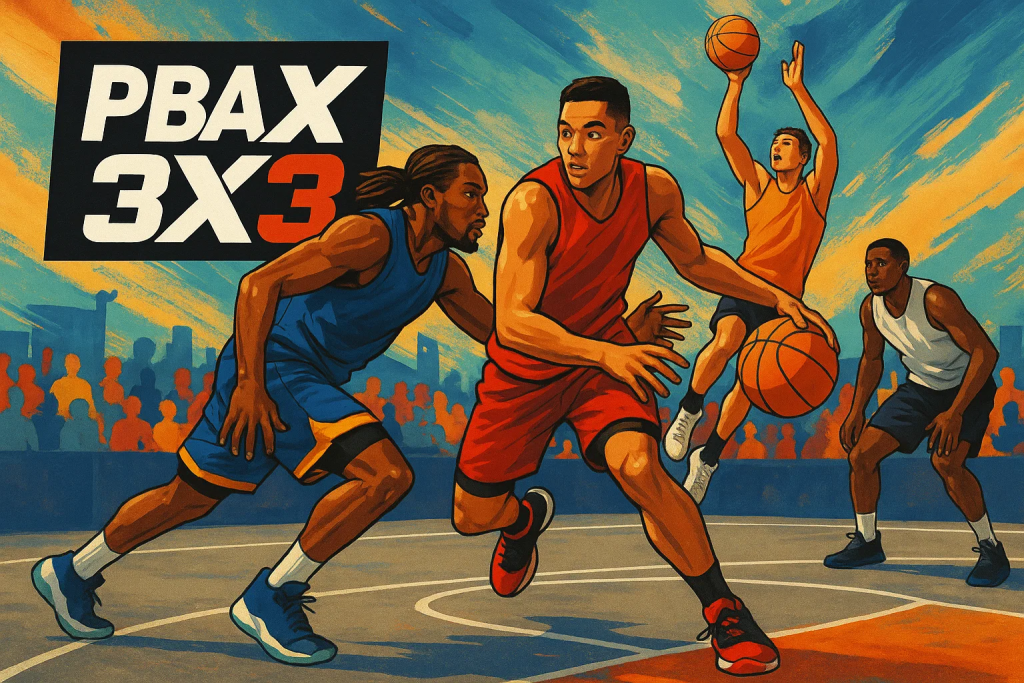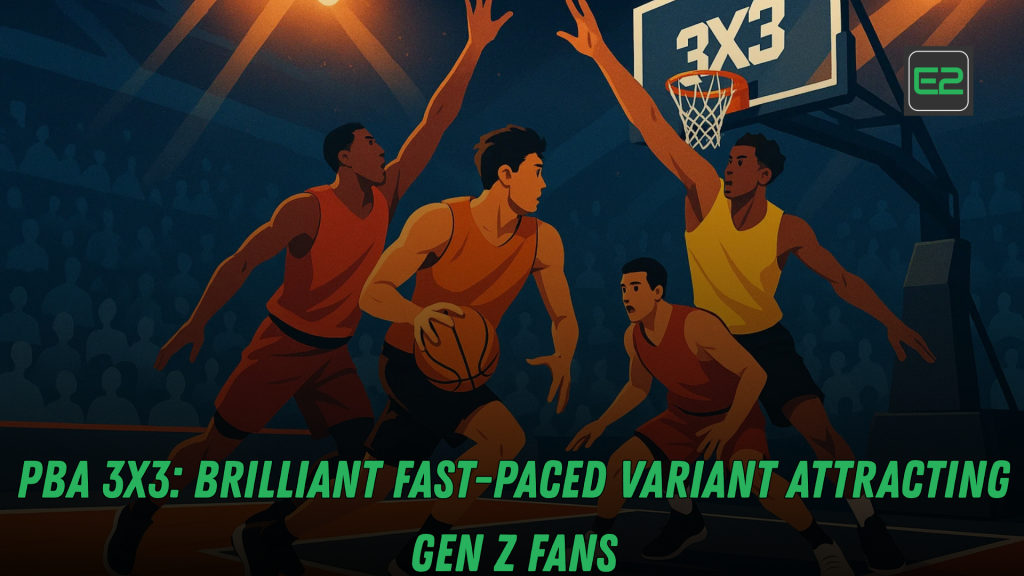Table of Contents
Executive summary
- PBA 3×3 mirrors the modern 3×3 template: half court, 12-second shot clock, a 10-minute game that ends when a team hits 21—an algorithm-friendly format for highlight culture.
- Gen Z’s viewing habits favor short, vertical video and interactive live streams; PBA 3×3 maps perfectly to that rhythm with near-constant plays worth clipping and sharing.
- With compact “leg” scheduling, sponsor-ready activations, and creator-friendly content, PBA 3×3 doubles as a sports product and a media engine that can scale across platforms.
What is PBA 3×3 and why it fits Gen Z
At its core, PBA 3×3 is basketball in concentrate—no filler, minimal downtime, and frequent peaks. Three players per side occupy a half court, possessions last 12 seconds, and the contest ends at 21 points or 10 minutes. That structure forces urgency: instead of slow build-ups, you get constant movement, quick reads, and rapid transitions.
Equally important is how audiences experience the product. On phones, attention is elastic and fiercely contested. PBA 3×3’s density of events—drives, kick-outs, corner twos, and switch-heavy defense—creates a highlight stream that feels native to vertical feeds. This is not just a different kind of game; it’s a different kind of viewing, engineered for swipes, taps, and shares.

Rules that shape the pace of PBA 3×3
Several rules give the format its signature speed:
- 12-second shot clock: Strategy condenses. Teams run handoffs and quick slips rather than deep playbooks.
- Scoring logic: One point inside the arc, two outside. The math rewards space creation, decisive drives, and clean kick-outs.
- Live restarts: After a make, the ball checks out and play resumes immediately—no languid jogs up the floor.
In practice, that means fewer lulls and more decisive mini-battles. You’ll see repeated micro-situations—drag screens near the arc, empty-corner handoffs, inverted mismatches—that teach casual fans how the format “thinks.” When audiences can read the patterns, PBA 3×3 becomes both addictive to watch and easier to analyze.
Gen Z media habits and the PBA 3×3 content flywheel
Gen Z lives in the feed. They don’t merely tune in; they co-create and co-distribute. That is why the best 3×3 programs treat the game as a generator of serial micro-stories:
- Clip-first workflows: Every 10-minute game can produce a dozen vertical moments (6–30 seconds) posted in real time. The quicker the turnaround, the stronger the algorithmic lift.
- Creator co-streams: Let basketball creators simulcast with their own styles—playful, technical, comedic—to meet different taste clusters within the same audience.
- POV access: Mic’d-up snippets, bench chatter, referee exchanges, and inbound huddles give the “you are there” feeling that vertical viewers love.
- Light gamification: Live polls (“take the deuce or drive?”), predictions (“who scores next?”), and sticker votes for the player of the leg spark constant micro-engagement.
When these elements feed one another—game → clip → conversation → co-stream → merch drop—you get a flywheel. The product doesn’t just finish at the buzzer; it keeps compounding in the feed long after the lights go out, and PBA 3×3 becomes a year-round conversation rather than a one-off event.
Designing a leg as a mini-festival for PBA 3×3 fans
A signature advantage of the format is portability. You can stage an entire leg in a mall, a compact arena, or a public square. Think of it as a traveling, many-layered spectacle:
- Atmosphere management: A DJ bridges games with beats that match the tempo; an MC keeps the narrative flowing so energy never dips between tip-offs.
- Interactive sponsor booths: Two-point challenges, 12-second “speed rounds,” and sensor backboards that track arc and release produce data-enhanced bragging rights.
- Creator pit: Designated angles and lighting allow content creators to film clean vertical footage without obstructing fans.
- Pop-up retail: Capsule merchandise keyed to the city or leg builds the thrill of limited runs.
Operationally, this festival model creates a natural spending loop. Fans orbit the court, booths, and shop, never feeling they’ve missed the action—and PBA 3×3 gains both atmosphere and incremental revenue every 10 minutes.
On-court tactics that pop in PBA 3×3
Because time is scarce and space is compressed, tactics emphasize clarity and speed:
- Instant spacing: Off the check, one player shallow cuts to the dunker spot, one pins a defender with a ghost screen, and one bounces to the arc for a catch-and-shoot.
- DHO chains: Dribble handoffs at the arc trigger switches and force corner help, opening the kick-out for a two.
- Short-roll reads: Versus traps, the screener slips to the nail, then snaps a pass to a relocating shooter.
- Rebound-to-deuce: Securing a board and pushing to a quick two is the 3×3 version of a fast break.
These choices look terrific on camera and they’re strategically sound. With the right principles—shot-quality math, switch rules, and rebound discipline—teams can play beautiful basketball that also scales into repeatable wins inside PBA 3×3.
A match-to-leg content lifecycle for PBA 3×3 teams
Smart organizations design content as deliberately as they design plays. Here’s a simple lifecycle that transforms every game into a week’s worth of media:
Pre-game (H-24 to H-1)
- Teaser (15 seconds) with a must-watch hook
- Confirmed lineup graphic and a “choose your scorer” poll
- One mini-interview revealing a tactical wrinkle to watch
In-game (live)
- Hot cut of each two-point make within 120 seconds
- Data overlay on a timely clip: “4–0 run in 32 seconds”
- Comment prompts (“double the handler or switch the screen?”)
Post-game (D+0)
- 60–90 second recap with three best plays
- A bench-reaction montage
- A “numbers card” (shot selection, touches, paint points)
Post-leg (D+1 to D+3)
- Mini-doc: “Inside the 12-second decisions”
- Coach whiteboard: 3 adjustments that swung the day
- Community feature: the loudest fan signs and fits
Because everything is templated and timed, creators can deploy pieces at pace, guaranteeing that PBA 3×3 stays sticky in feeds as the week rolls on.
Monetization: turning PBA 3×3 moments into revenue
The business model is richer than ticketing alone. Consider a “stacked” approach:
- Sponsorship layers: Presenting partner for Top Plays; branded halftime skill contests; AR filters that unlock coupons.
- Flexible tickets: Half-day and full-day passes, student bundles, and last-hour flash deals drive different budgets into the venue.
- Capsule merch: City-themed drops, limited player patches, and leg-exclusive tees feed urgency.
- Premium media: Coach-cam, long-form mic’d-up, and masterclasses gated for members.
- Digital collectibles: Verified moments from a leg—“The 7-0 burst”—as scarce items fans can trade or redeem for perks.
When each highlight is also a doorway into a product, PBA 3×3 begins monetizing attention in parallel with engagement.
Broadcast UX: building two-screen magic for PBA 3×3
The ideal broadcast respects that the phone is king. A best-in-class experience looks like this:
- Shot-clock centerpiece: A crisp, readable 12-second timer that anchors the eye on small screens.
- Context cues: Subtle glow on two-point makes; a tiny “run” badge when momentum flips.
- Angle choice: Viewers switch between broadcast cam, courtside cam, and creator cam with one tap.
- Micro-polls: In-stream votes on whether to switch or trap the handler; results appear before the next possession.
- Minimal overlays: Keep data digestible—two or three metrics, max—so vertical viewers never feel crowded.
This two-screen choreography—watching and tapping—elevates retention and share rates, the two metrics that sustain discoverability for PBA 3×3.
Building a fan journey: from scroller to superfan
A sustainable audience comes from guiding casuals through a series of commitments:
- Discovery: Vertical teasers, meme-ready clips, and creator duets pull people in.
- Interaction: Quick polls, prediction games, and Q&A stickers invite low-friction participation.
- Conversion: Newsletter sign-ups, schedule alerts, and micro-offers for first-time tickets.
- Loyalty: Members-only streams, early merch access, and local meet-ups that deepen identity.
Plan the nudges across platforms and you’ll see scrollers graduate into superfans who carry PBA 3×3’s message farther than ads ever could.
What teams need to “show up” consistently
Coaches and players can help multiply the league’s reach by becoming content-competent:
- Tactical 30s: One-minute explainers—why a ghost screen worked, when to hunt the mismatch, how to read weak-side tags.
- Skill capsules: Footwork for step-backs, balance drills for off-the-catch twos, finishing through contact.
- Prep & recovery: A 5-minute routine for glutes and hips, ankle prehab, nutrition on double-leg days.
- Locker-room leadership: A captain’s 20-second address before a deciding game, captured and shared.
This humanizes the competition while giving fans ideas to practice, making the PBA 3×3 ecosystem feel participatory rather than distant.
The media toolkit: a practical checklist
- Graphic templates: Scoreboards, 12-second timers, run tags, and clean lower-thirds.
- Caption playbook: A 3-part structure—hook, context, call to action—tailored for each platform.
- Vertical filming guide: Framing, distance, and audio tips so creators can capture crisp courtside angles.
- Posting cadence: Pre-game, mid-game, post-game, and post-leg rhythms that audiences can expect.
- Hot-cut pipeline: One person logs plays, one cuts, one approves, one posts—no bottlenecks.
A toolkit enables repeatability, and repeatability is the secret to compound growth for PBA 3×3 content.

Common mistakes and how to fix them
- TV-first thinking: Prioritizing horizontal broadcasts and treating vertical as leftovers. Flip the script—vertical is primary.
- Slow hooks: If a clip doesn’t earn attention in three seconds, it dies in the feed. Front-load the twist.
- Hard-to-reach venues: Favor places with natural foot traffic to maximize discovery.
- Closed media policy: Over-policing reposts suffocates organic reach. Enable controlled remixing.
- No analytics: If you’re not tracking retention, shares, and merch CTR, you’re flying blind.
Tightening these basics quickly lifts the visibility and conversion of PBA 3×3 across channels.
Key skills for modern 3×3 players
To thrive in the format’s time-pressure cooker, players should emphasize:
- First-step pop & deceleration: Burst to gain a cushion, then stop on a dime to rise for a deuce.
- Switch communication: Clean calls avoid free lanes and panic fouls.
- Rebound discipline: One body finds contact, one hunts the kick-out spot, one reads the carom.
- Shot-quality math: A contested long two early in the clock usually loses the possession battle; the best teams understand expected value.
- Intermittent conditioning: Ten minutes at high intensity demands repeat sprint ability more than marathon endurance.
Sharpening these skills makes the play tighter and the highlight reels richer, which is perfect for the growth loop of PBA 3×3.
Brand collaborations: examples that click
- Telco / devices: Data-backed contests (“Predict the next deuce”) with instant rewards.
- Energy drinks: 21-in-60 challenges at booths, with leaderboards and stage shout-outs.
- Streetwear labels: City-specific capsules tied to each leg’s palette.
- Digital wallets: QR-based cashback for in-venue merch and snacks.
- Local food heroes: Curated “game day” bites turn matches into culinary mini-tours.
These integrations turn casual spectators into active participants and anchor PBA 3×3 in local culture.
SEO foundations for durable visibility
Social virality is great; search durability compounds it. Structure your editorial as a topical hub:
- Core topics: Schedule, results by leg, standings, team/player profiles, rules explained in plain language.
- On-page discipline: Clean headings, descriptive alt text, and concise metadata.
- Structured data: Event markup for legs and organization markup for teams to enrich search snippets.
- Evergreen hubs: A central landing page that aggregates highlights and recaps from each leg, so newcomers can binge without getting lost.
When search and social strategies align, PBA 3×3 earns both bursts and long tails.
A 12-month plan: from pilot to scale
Quarter 1 – Lay the foundation
- Finalize graphic templates, SFX stings, and vertical filming guidelines.
- Launch a microsite with live scores, schedule, and highlight hubs.
- Sign 10–20 creator partners for recurring co-streams.
Quarter 2 – Community lift-off
- Stage four to six legs in foot-traffic hubs; each leg features a bespoke capsule.
- Introduce a free-to-join fan program with points for watching, voting, and checking in.
- Release a “Behind the 12 seconds” mini-documentary series.
Quarter 3 – Revenue optimization
- Package sponsorable content blocks (Top Plays, Mic’d-up, Data Spotlight).
- Launch digital collectibles redeemable for meet-and-greets or VIP seating.
- Test ticket bundles (half-day + merch + creator photo op).
Quarter 4 – Review and reinvest
- Publish a sponsor report (reach, watch time, retention, conversion).
- Survey fans for NPS and venue preferences.
- Lock next season’s dates and venues early to secure partners and creators around PBA 3×3.
International gateway and future-proofing
Because 3×3 is globally standardized and Olympic-ready, international collaboration is a natural horizon. Consider:
- Cross-border legs: Invite regional teams to a showcase leg; co-produce bilingual highlight packs.
- Multi-language captions: Translate top content for Southeast Asian and global audiences.
- Talent pipeline: Connect streetball circuits, academies, and pro teams to cultivate future stars and broaden the base of PBA 3×3.
The more porous the borders, the larger the fan map becomes.
Community at the center
A vibrant community keeps the conversation alive between legs:
- Fan hubs: Dedicated groups with AMAs, film rooms, and creator contests.
- UGC spotlight: Weekly showcases of the best remixes, parodies, and “coach mode” breakdowns from fans.
- Campus ambassadors: Student crews who help staff events, seed content, and host viewing parties.
When fans feel ownership, they don’t just attend—they recruit, which is the most authentic growth engine for PBA 3×3.
A 30-day quick-start checklist
- Week 1: Lock vertical templates and build a library of three-second hooks.
- Week 2: Onboard local creators; test one co-stream with reaction overlays.
- Week 3: Set up a mall booth with a 12-second skill challenge to prime discovery.
- Week 4: Publish a recap formula (one 60–90s edit + ten verticals), then analyze retention and share rates to refine.
Small sprints reveal what truly resonates at the pace of the format.

Call to action
Whether you’re a fan, a creator, a marketer, or a brand: now is the moment to jump in. Subscribe for weekly schedules and highlight packs, pitch a co-stream concept, or trial a single-leg sponsorship to measure real lift. The door is open, the pace is set, and every 12-second decision can be a story people remember—especially when PBA 3×3 meets the energy of a generation that lives on speed, style, and community.
Frequently asked questions (FAQs)
1) How is PBA 3×3 different from 5-on-5 basketball?
It’s half court with three players per side, a 12-second shot clock, and a 10-minute cap or first to 21. Possessions are shorter, spacing is tighter, and games feel like highlight reels stitched together—exactly why PBA 3×3 thrives on mobile.
2) Why does this format resonate so strongly with Gen Z?
Because it matches their content habits: short, vertical, interactive, and authentic. The flow lends itself to live polls, creator reactions, and quick cuts, making PBA 3×3 a natural citizen of social feeds.
3) What’s the best way to start following without getting overwhelmed?
Begin with leg recaps, follow two or three teams, set schedule alerts, and prioritize “Top Plays,” mic’d-up moments, and the post-leg mini-docs. Within days you’ll understand the rhythms of PBA 3×3.
4) Which skills should aspiring 3×3 players develop first?
Explosive first steps, controlled stops for twos, clean switch communication, rebound-to-kickout instincts, and intermittent conditioning. Mastering these makes you valuable in PBA 3×3.
5) How should brands approach sponsorship?
Pilot a single leg with an interactive booth and a content block (such as Top Plays), then measure reach, retention, shares, and ticket/merch conversions. If the data’s strong, scale your presence around PBA 3×3 for sustained impact.
